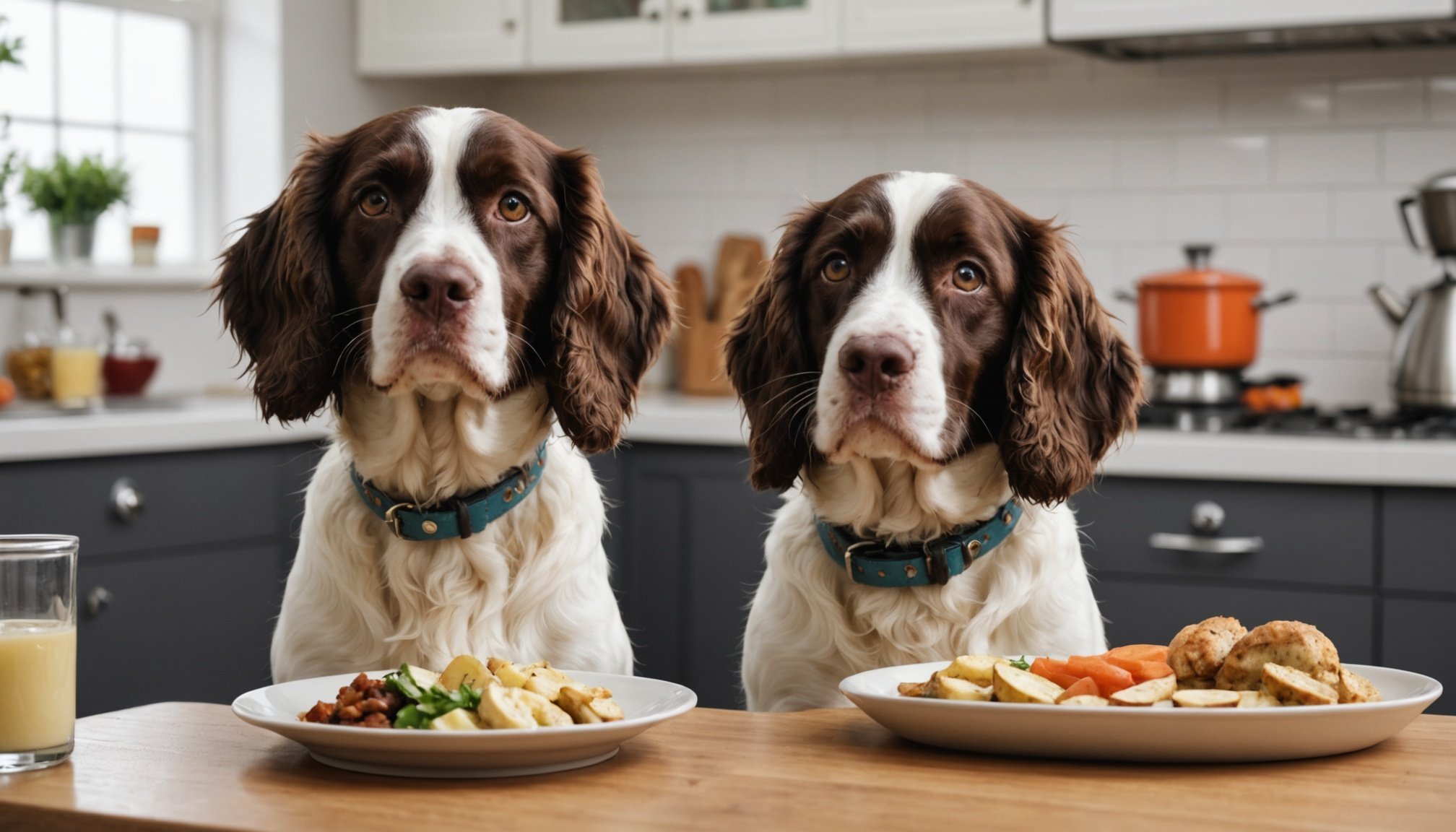Understanding Food Allergies in English Springer Spaniels
Food allergies among pets can be frustrating, especially within breeds like the English Springer Spaniel. These allergies are often triggered by proteins found in common ingredients like beef, chicken, and dairy. It’s crucial for owners to understand the symptoms of allergies to provide the best care for their furry companions.
Recognising the symptoms of allergies in an English Springer Spaniel can be challenging but is essential. Typical signs include itchy skin, chronic ear infections, and digestive issues such as diarrhoea or vomiting. These symptoms might be mistaken for other health issues, which makes pinpointing food allergies more complex.
This might interest you : Achieving tranquility: proven strategies to maintain your vizsla”s focus during agility competitions
To ensure a proper diagnosis, consulting a veterinarian is paramount. They can run tests and recommend an appropriate elimination diet to identify specific allergens. It’s important to follow the vet’s guidance diligently, as managing a food allergy involves avoiding exposure to the allergen entirely.
An understanding of how these allergies manifest can greatly enhance your pet’s quality of life. Having a plan in place will help equip you to manage unexpected symptoms effectively and keep your English Springer Spaniel comfortable and healthy.
Additional reading : Mastering leash training: proven techniques for a well-behaved gordon setter
Nutritional Requirements for English Springer Spaniels
Ensuring that your English Springer Spaniel receives all necessary nutritional needs is crucial for maintaining their overall health. This breed requires a well-balanced diet to support their active lifestyle. The key to a healthy diet lies in understanding their essential nutrients, which include proteins, fats, and carbohydrates.
Essential Nutrients
Protein is pivotal, aiding muscle development and repair. Look for high-quality animal proteins as the primary ingredient in their diet. Fats, on the other hand, provide energy and help maintain a healthy coat. Healthy fats, such as omega-3 and omega-6 fatty acids, are vital. Carbohydrates should be included but in moderation, serving as a supplementary energy source.
Macronutrient Ratios
English Springer Spaniels thrive on specific macronutrient ratios: approximately 22-26% protein, 10-15% fat, and 40-45% carbohydrates. These ratios can vary based on their activity level, age, and health status.
Vitamins and Minerals
Ensure incorporation of essential vitamins like A, D, E, and B-complex, and minerals such as calcium and phosphorus. These nutrients support bone health, immune function, and overall vitality. Whether opting for quality commercial feeds or crafting home-cooked meals, careful planning is essential to meet these nutritional requirements.
Safe Ingredients for Homemade Dog Food
Crafting homemade dog food requires careful selection of safe ingredients to ensure nutritional balance and well-being for your pet.
List of Safe Proteins
Providing high-quality protein is essential for your canine’s diet. Some pet-friendly foods include lean meats like chicken, turkey, and beef. These sources are rich in amino acids necessary for muscle development and maintenance. For allergen-free options, consider fish such as salmon or cod, which also offer beneficial omega-3 fatty acids. Egg whites, free from yolk, serve as another excellent protein source.
Recommended Carbohydrates
Carbohydrates provide energy and are crucial for digestive health. Oats and brown rice are gentle carbohydrate sources and suitable for sensitive stomachs. Sweet potatoes and peas also hydrate and nourish without causing dietary disruptions. These allergen-free options help avoid triggering any sensitivities in your pet.
Safe Vegetables and Fruits
Incorporating safe vegetables and fruits adds fibre and essential vitamins. Carrots and green beans are reliable choices, while apples and blueberries offer antioxidant benefits. Avoid those toxic to dogs, such as grapes and onions, instead opting for pet-friendly foods like pumpkin. Ensuring a varied and balanced menu supports your dog’s overall health and well-being.
Recipes for Home-Cooked Meals
Cooking homemade meals for dogs means having full control over the ingredients, which can be a game changer for pups with allergies or specific dietary needs. Here are a few allergen-free recipes to try:
Recipe for Chicken and Sweet Potato
For this simple yet nutritious meal, you’ll need boneless chicken breast and sweet potatoes. Start by boiling the chicken until fully cooked, then shred it into small pieces. Peel and cube the sweet potatoes, and boil them until soft. Mash the sweet potatoes and mix thoroughly with the shredded chicken. This recipe is rich in protein and carbohydrates, supporting your dog’s energy levels.
Recipe for Beef and Quinoa
Combine lean ground beef with cooked quinoa for a wholesome dish. Brown the beef in a skillet until it’s fully cooked, then drain any excess fat. After cooking the quinoa, mix it with the beef. Quinoa offers a source of fiber and essential amino acids. To tailor recipes to specific allergies, consider substituting ingredients while maintaining nutritional balance, like swapping chicken for turkey if poultry sensitivities exist.
Recipe for Fish and Veggies
Use white fish, such as cod, with a variety of vegetables like carrots and peas. Bake or steam the fish and mash it with cooked veggies. This meal is packed with omega-3 fatty acids for a healthy coat.
Common Allergens to Avoid
When considering dog food, recognising allergens to avoid is crucial, especially for pets with food sensitivity. Many commercial dog foods contain ingredients that can trigger allergic reactions. It’s important to be aware of these common culprits to keep your dog healthy and comfortable.
Various allergens including beef, dairy, wheat, chicken, and corn are prevalent in many dog foods. These, among others, can pose risks to dogs with specific sensitivities. For example, a dog allergic to beef may react violently if given a product containing beef protein, resulting in symptoms like itching or digestive upset.
Identifying and understanding these harmful ingredients allows pet owners to make informed decisions. Ingredients that pose risks should be carefully scrutinised on food labels. Opt for alternatives such as lamb or venison if chicken is a known allergen for your pet. Similarly, replacing wheat with rice or quinoa offers hypoallergenic options for sensitive dogs.
Employing diets free from specific allergens can drastically improve your dog’s health. Exploring grain-free or limited-ingredient foods are viable pathways to bypass allergies, ensuring your pet receives the nutrition they require without the associated risks from harmful ingredients.
Tips for Preparing and Storing Home-Cooked Meals
Preparing home-cooked meals, especially for your beloved pets, requires careful attention to meal prep and safe cooking practices. Ensuring freshness and safety begins with choosing fresh ingredients and using clean utensils. It is crucial to cook food thoroughly to eliminate harmful bacteria, maintaining a temperature safe enough to kill pathogens.
To ensure your meals remain nutritious and uncontaminated, transfer any leftovers into airtight containers. This helps preserve food quality and prevent bacterial growth during food storage. Avoid keeping any uneaten meals at room temperature for more than two hours, as this can promote the growth of harmful microorganisms.
Transitioning a pet to a home-cooked diet requires gradual changes. Start by mixing portions of home-cooked food with their usual food, gradually increasing the homemade portion while observing your pet’s response. Consult a vet to ensure the new diet meets all nutritional needs.
Storing homemade dog food safely involves refrigerating in airtight containers. For longer storage, consider freezing portions. Be mindful of your pet’s dietary requirements and any allergies they may have, adjusting ingredients accordingly. Regularly check food for spoilage and adhere to expiration timelines.
Consulting with Veterinarians and Nutritionists
When caring for your pet’s dietary needs, seeking veterinary advice is paramount. Professional input from a pet nutritionist ensures that your animal receives a balanced diet tailored to their specific needs. These experts offer professional guidance that considers factors such as age, breed, and health status.
Finding a qualified veterinary nutritionist might seem daunting, but there are some practical steps you can take. Begin by asking your regular veterinarian for recommendations. They often have a network of specialists and can vouch for their credibility. Additionally, search through directories of certified nutritionists affiliated with professional veterinary associations, ensuring they hold appropriate credentials and experience.
Once you’ve chosen an expert, there are vital questions you should ask during consultations to maximise the benefit of their professional guidance. Inquire about the specific nutritional needs of your pet’s breed and how these may change over time. Discuss how different life stages or medical conditions might alter dietary requirements. It’s also wise to question their approach to balancing home-cooked versus commercial diets.
This approach guarantees your companion receives optimal care, fostering better health and longevity. Providing awareness to the owners on the importance of veterinary advice can make a substantial difference in a pet’s well-being.
Addressing Common Concerns with Home-Cooked Diets
When considering home cooking for your pet, it’s natural to have concerns about whether such diets meet their nutritional needs. One common myth is that homemade meals lack essential nutrients. However, a well-researched and balanced approach can address these pet dietary issues effectively.
Many pet owners worry about the adequacy of homemade diets. The key to ensuring a balanced diet lies in understanding your pet’s specific nutritional requirements and working with a veterinarian or a pet nutritionist to tailor meals appropriately. Pets can thrive on home-cooked diets that are carefully composed to include all necessary elements, such as proteins, fats, vitamins, and minerals.
Debunking Myths and Understanding Benefits
It’s vital to debunk misconceptions about homemade meals being inherently inferior to commercial foods. In reality, these diets, when well-prepared, can offer more control over ingredient quality and provide solutions to certain pet dietary issues, such as allergies or intolerances.
Long-term health benefits are significant when bespoke diets address specific health concerns, leading to improved overall wellness. It’s important to approach home-cooked diets with proper guidance to ensure they contribute positively to your pet’s health journey. Through conscious planning, the transition to home-cooked meals can be both manageable and beneficial.











